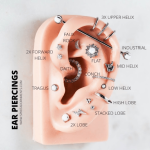Getting an ear piercing is exciting. It lets you express yourself. But sometimes, infections can happen. Knowing the signs of an infection is important. This guide will help you understand how to tell if your ear piercing is infected.
What is an Ear Piercing Infection?
An ear piercing infection happens when germs enter the skin. This can cause swelling and redness. It may also lead to pain and other symptoms. Infections can happen in new piercings or old ones. It is important to take care of your piercings.
Signs of an Infected Ear Piercing
There are several signs to look for. Here are the most common ones:
- Redness: The skin around the piercing may look red.
- Swelling: The area may feel swollen or puffy.
- Pain: You may feel pain or tenderness.
- Heat: The area may feel warm to the touch.
- Pus: You may see yellow or green fluid.
- Foul Smell: There may be an unpleasant smell.
- Fever: You might feel sick or have a fever.
Why Do Infections Happen?
Infections can happen for many reasons. Here are some common causes:
- Dirty Hands: Touching your piercing with dirty hands can cause germs to enter.
- Unclean Jewelry: Using jewelry that is not clean can lead to infections.
- Improper Care: Not taking care of the piercing can cause problems.
- Allergic Reactions: Some people are allergic to certain metals.
- Trauma: Bumping or pulling on the earring can cause damage.
How to Care for Your Piercing
Taking care of your piercing is very important. Here are some tips:
- Wash Your Hands: Always wash your hands before touching your piercing.
- Clean the Area: Use a saline solution to clean the area around the piercing.
- Do Not Touch: Try not to touch your piercing too much.
- Use the Right Jewelry: Choose jewelry made for piercings. Look for surgical steel or titanium.
- Change Jewelry Carefully: If you change your earrings, make sure they are clean.
- Avoid Swimming: Stay away from pools, lakes, or oceans until it heals.
.png)
Credit: www.entandallergy.com
What to Do If You Suspect an Infection
If you think your ear piercing is infected, take action. Here’s what to do:
- Stay Calm: Do not panic. Infections can often be treated.
- Clean the Area: Gently clean the piercing with saline solution.
- Avoid Removing Jewelry: Keep the earring in place unless told otherwise.
- Watch for Symptoms: Keep an eye on the signs of infection.
- See a Doctor: If symptoms worsen, visit a doctor or a professional piercer.

Credit: www.nhs.uk
When to See a Doctor
Sometimes, you need to see a doctor. Here are some signs that mean you should get help:
- Severe Pain: If the pain is too much, go to a doctor.
- Spreading Redness: If redness spreads beyond the piercing.
- Fever: If you have a fever over 100.4°F (38°C).
- Pus: If there is a lot of pus or it is green/yellow.
- Swollen Lymph Nodes: If you feel swollen glands in your neck or underarms.
Preventing Ear Piercing Infections
Prevention is better than cure. Here are some ways to prevent infections:
- Choose a Professional: Get your piercing done by a trained professional.
- Follow Aftercare Instructions: Always follow the aftercare advice given.
- Avoid Touching: Do not touch your piercing with unwashed hands.
- Limit Changing Jewelry: Wait until it’s fully healed to change earrings.
What Happens if an Infection is Left Untreated?
If you ignore an infection, it can get worse. Here are some possible issues:
- Increased Pain: The pain may become severe.
- Spread of Infection: The infection can spread to nearby areas.
- Abscess Formation: Pockets of pus may form under the skin.
- Scarring: You may end up with scars on your ear.
- Loss of Piercing: You might lose the piercing entirely.
Frequently Asked Questions
How Can I Tell If My Ear Piercing Is Infected?
Look for redness, swelling, or pus around the piercing. Pain and warmth may also indicate infection.
What Are The Common Symptoms Of An Infected Ear Piercing?
Common symptoms include itching, a bad smell, and discharge. Fever may occur in severe cases.
How Soon After Piercing Can An Infection Occur?
Infections can happen within a few days or weeks after piercing. Proper care helps reduce this risk.
Should I Remove My Earring If It’s Infected?
Removing the earring can worsen the infection. Consult a doctor for the best advice.
Conclusion
Infections in ear piercings can happen. Knowing the signs is very important. If you notice redness, swelling, or pain, take action. Clean the area and watch for changes. If things get worse, see a doctor. By caring for your piercing, you can help prevent infections. Enjoy your new piercing safely!




